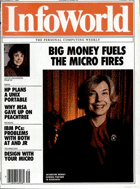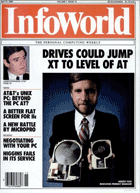Apple Rumors: The Early Years
Hot gossip about the Apple III, the Lisa and "McIntosh," and the company's post-Jobs fate.By Harry McCracken | Monday, September 28, 2009 at 2:13 am
The Apple Tax, Circa Early 1984
 “Inside Track,” by John C. Dvorak, January 24th, 1984
“Inside Track,” by John C. Dvorak, January 24th, 1984
Shortly after the announcement of the Macintosh, Dvorak says that Apple charges too much (sound familiar?) and compares its marketing and pricing strategy to that of other leading PC companies of the era:
What the automatic transmission did for the automobile is what is what the Macintosh concept will do for personal computers.
Note that I use the word concept. I think the Mac is a great computer, OK? But besides being easier to use, what does it do that a $1,500 Morrow Micro Decision can’t do? And no, I don’t own Morrow stock.
The fact of the matter is that we are living in a price-driven environment, and Apple continues to ignore the BSFD marketing maxim: benefits sell–features don’t.
What irks me about all this is that I’m rooting for Apple to have a hit, and I do like the Mac. The simple truth is that people want single-board computers to sell for less than $2,000, and they want free software. That’s all there is to it. Osborne knew this, KayPro knows this, IBM knows this, Morrow knows this, everyone knows it except Apple.
So here is the scenario: There will be a surge of interest in the Mac from people like myself who collect hardware. Then it will begin to get used in the office in a cult fashion, similar to the Apple II phenomenon. Unfortunately, it took years before the big Apple II surge took place. Apple can’t afford to wait that long. IBM has a similar machine in the wings and so do the Japanese.
What happened? Osborne was bankrupt when this was written; Kaypro went bankrupt in 1992; IBM divested itself of its PC business in 2004; Morrow went bankrupt in 1986. Apple? Still in business, still catching flack for charging too much.
Dvorak’s forecast of the Mac’s sales trajectory was pretty accurate, except that it turned out that Apple was able to wait until the Mac got some traction. I’m not sure what the Mac-like computers were from IBM (unless Dvorak was referring to Windows 1.0) and the Japanese, though.
If Woz Says It, It Must be True
 “16-Bit Apple IIx Alive and Well,” by Christine McGeever, November 19th, 1984
“16-Bit Apple IIx Alive and Well,” by Christine McGeever, November 19th, 1984
An InfoWorld reporter gets a scoop from a source within Apple who’s in a position to know–and who’s even willing to be quoted on the record:
In an exclusive interview with InfoWorld, Apple Computer co-founder Stephen Wozniak confirmed that work has begun on the next generation Apple II machine, dubbed the IIx. The computer, which won’t be available until 1986, may be targeted towards business users and won’t compete with sales of the IIc, according to Wozniak.Wozniak says the 16-bit machine will have some of the features of the portable IIc, such as a built-in disk drive, and some of the features of the IIe, such as expandable memory and add-on slots. It will also use Apple’s ProDOS operating system. A prototype of the computer has been built, and Wozniak reportedly has one in his office.
(snip)
The IIx has not been a secret Apple project, although it has frequently been rumored to be canceled or suspended.
What happened? The Apple IIx was real–but that’s not the same thing as really being released. Wozniak and others within the company grappled with technical gremlins. This Apple IIx history says it was killed by technical gremlins, but it also says that the project was killed in March 1984, months before the InfoWorld story appeared. I’m guessing that it was at least kind of alive when InfoWorld wrote about it, though, given that other computer magazines also thought it was extant at the same time. Or perhaps the late-1984 incarnation of the IIx was the machine that shipped in 1986 as the IIGS.
Lisa to Disappear, Macs to Multiply
 “From the News Desk,” Michael McCarthy, December 3rd, 1984
“From the News Desk,” Michael McCarthy, December 3rd, 1984
InfoWorld thinks that the Lisa has a dicey future, and then crams an amazing quantity of rumors into one paragraph:
Our tip two weeks ago that Apple is planning to drop the Lisa line in 1985 really stirred things up. At a scheduled meeting with financial analysts, Steve Jobs and John Sculley specifically denied the claim both to the analysts and to our reporter. Lisa won’t be going away, they insisted…Denials notwithstanding, analysts and observers continue to find the idea of Apple dropping Lisa very plausible. Sources inside Apple tell us the big cheeses there have been holding meetings all week after reading our Lisa item, which also mentioned the 16-bit Apple IIx that Stephen Wozniak told us he was starting on. Seems that everyone’s mad at everyone else, and that Woz’s IIx project may be sacrificed to propitiate the gods at Apple.
As long as we’re at Apple, let’s review our files for the week’s collection of unsubstantiated rumors. There are enough rumored new Macintoshes to sell out the Highland Games: the color Mac, the Unix Mac, the flat-screen Mac, the Mac with the 8-1/2-by-11-inch full-page screen, and the souped-up, faster processor Mac, which may or may not be a multitasking, multiuser Mac…the color Mac, some say, may be introduced at Comdex. Others say it will be introduced at the annual meeting in January, and still others say technical difficulties mean no color for many moons to come.
What happened? Some tips are dead on–Apple discontinued the Lisa in April of 1985. Everything else mentioned in the story came to be, but it took a long time. Apple didn’t release color Macs until many moons later, when it shipped the Macintosh II (which was also the first faster-processor Mac) in 1987; it released the first Mac flavor of Unix in 1988; it released a full-page portrait display for modular Macs in 1989. As far as I can remember the first flat-screen Mac that wasn’t a laptop was 1997’s Twentieth Anniversary Macintosh.
Apple II Forever, or at Least Until 1993
 “Apple II Shakes Controversy,” an interview with Del Yocam, April 15th, 1985
“Apple II Shakes Controversy,” an interview with Del Yocam, April 15th, 1985
InfoWorld interviews Del Yocam, head of Apple’s Apple II division, and quotes him as saying:
We really believe the Apple II can live forever…between 60 percent and 80 percent of all microcomputer users may never need any more than 8-bit technology…there are certainly those out there who feel we need to have 16-bit microprocessors, so we are certainly looking at that seriously.
What happened? Apple discontinued the 8-bit Apple IIe in 1993, ending an amazing long run given that the rest of the industry had long ago moved to 16-bit CPUs. Along the way, the company introduced one 16-bit Apple II model, the IIGS, but it died a few months before the IIe did. As for 60 to 80 percent of computer users “never” needing anything better than 8-bit technology–when was the last time you saw a computer that had fewer than 32 bits?
2 Comments
Read more:













September 28th, 2009 at 9:16 am
Hi Harry —
I did not know Google had all those old Infoworlds online. Thanks for the link — it was strange to see all my work from 1990 for the first time in 19 years…
— Paul
September 28th, 2009 at 1:52 pm
Great, wonderful, fantastic excursion down memory lane. You did some incredible research, unearthing a series of gems about the early years. It would have been so cool to have had an Apple II laptop… or a mini-Newton… Sculley probably has a smile on his face given all the discussions about the iTablet– it’s the Knowledge Navigator reborn!
Dvorak certainly played a key role in writing about Apple and contemplating its next moves. (I remember his diatribe or rather satirical take on the original iBook– something about Barbie, cosmetic cases, and being a girlie computer. Of course, it did help save Apple’s bacon! I still enjoy Dvorak today on Cranky Geeks– he’s remarkably funny, personable, and opinionated–and his sidekick Sebastian Rupley is a great foil.)
What’s your sense from having done this about rumors then vs. rumors now? More accuracy, less? More frenzy, less? Better sources, fewer? More insider info vs. sheer speculation?